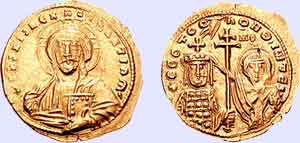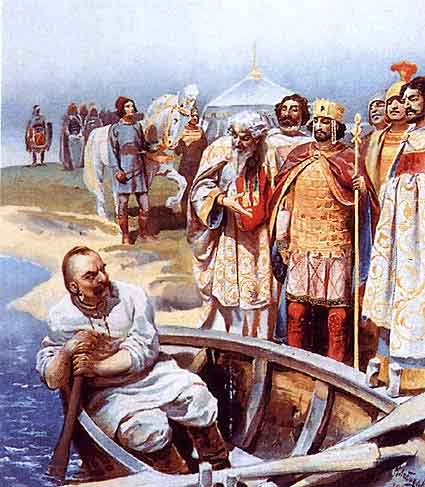.

Ioannes, protected by God and the Virgin Mary. [Source]
John I Tzimiskes or Tzimisces, (Greek: Ιωάννης Α΄ Τζιμισκής, Iōannēs I Tzimiskēs), (c. 925 – January 10, 976) was Byzantine Emperor from December 11, 969 to January 10, 976.
Background
John's real family name was Kourkouas and his nickname was derived either from the Armenian tshemshkik, meaning "red boot", or from an Armenian word for "short stature". He was born c. 925 to an unnamed member of the Kourkouas family by the sister of the future Emperor Nikephoros II Phoka. Both the Kourkouai and the Phokadai were distinguished Cappadocian families of Armenian origin, and among the most prominent of the emerging military aristocracy of Asia Minor. Several of their members had served as prominent army generals.
Contemporary sources describe John as a rather short but well-built man, with reddish blonde hair and beard and blue eyes who was attractive to women. He seems to have joined the army at an early age, originally under the command of his maternal uncle Nikephoros Phokas. The latter is also considered his instructor in the art of war. Partly because of his familiar connections and partly because of his personal abilities, John quickly rose through the ranks. He was given the political and military command of the province of Armenia before he turned twenty-five years old. His marriage to Maria Skleraina linked him to the influential family of the Skleroi.
Rise to the throne
At the time the Empire was at war with its eastern neighbor, the Abbasid Empire. Armenia served as the borderland between the two Empires. John managed to successfully defend his province. He and his troops joined the main part of the army, which was campaigning against the enemy under the command of Nicephorus.
Nikephoros (which means "bearer of victory") Phokas justified his name with a series of victories, moving the borders further east with the capture of about 60 border cities including Aleppo. By 962, the Abbasids had asked for a peace treaty with favorable terms for Byzantines, that secured the borders for some years. John distinguished himself during the war both at the side of his uncle and at leading parts of the army to battle under his personal command. He was rather popular with his troops and gained a reputation for taking the initiative during battles, turning their course.
Nikephoros (which means "bearer of victory") Phokas justified his name with a series of victories, moving the borders further east with the capture of about 60 border cities including Aleppo. By 962, the Abbasids had asked for a peace treaty with favorable terms for Byzantines, that secured the borders for some years. John distinguished himself during the war both at the side of his uncle and at leading parts of the army to battle under his personal command. He was rather popular with his troops and gained a reputation for taking the initiative during battles, turning their course.
On the death of Emperor Romanos II in 963, John urged his uncle to seize the throne. After helping Nikephoros II to the throne and to continuing to defend the empire's eastern provinces, John was deprived of his command by an intrigue, for which he retaliated by conspiring with Nikephoros' wife Theophano to assassinate him:

Svyatoslav I's meeting with Emperor John.
The murder was protracted by insult and cruelty: and as soon as the head of Nicephorus was shown from the window, the tumult was hushed, and the Armenian was emperor of the East. On the day of his coronation, he was stopped on the threshold of St. Sophia, by the intrepid patriarch; who charged his conscience with the deed of treason and blood; and required, as a sign of repentance, that he should separate himself from his more criminal associate. This sally of apostolic zeal was not offensive to the prince, since he could neither love nor trust a woman who had repeatedly violated the most sacred obligations; and Theophano, instead of sharing his imperial fortune, was dismissed with ignominy from his bed and palace. In their last interview, she displayed a frantic and impotent rage; accused the ingratitude of her lover; assaulted, with words and blows, her son Basil, as he stood silent and submissive in the presence of a superior colleague; and avowed her own prostitution in proclaiming the illegitimacy of his birth. The public indignation was appeased by her exile, and the punishment of the meaner accomplices: the death of an unpopular prince was forgiven; and the guilt of Zimisces was forgotten in the splendour of his virtues. - Edward Gibbon. The Decline and Fall of the Roman Empire.
Reign
After his coronation in December 969, John dispatched his brother-in-law Bardas Skleros to subdue a rebellion by Bardas Phokas, who aspired to succeed his uncle Nikephoros II. To solidify his position, John married Theodora, a daughter of Emperor Constantine VII. John proceeded to justify his usurpation by the energy with which he repelled the foreign invaders of the empire.
In a series of campaigns against the Kievan encroachment on the Lower Danube in (970–971) he drove the enemy out of Thrace, crossed Mt. Haemus and besieged the fortress of Dorystolon (Silistra) on the Danube. In several hard-fought battles he defeated Prince Svyatoslav I of Kiev so completely that he left Tzimiskes master of eastern Bulgaria and Dobruja.
On his return to Constantinople, Tzimiskes celebrated a triumph, divested the captive Bulgarian emperor Boris II of the imperial symbols, and proclaimed Bulgaria annexed. He further secured his northern frontier by transplanting to Thrace some colonies of Paulicians whom he suspected of sympathising with their Muslim neighbours in the east.
In 972 he turned against the Abbasid empire and its vassals, beginning with an invasion of Upper Mesopotamia. A second campaign, in 975, was aimed at Syria, where John's forces took Damascus, Caesarea, and Tripoli, but failed to take Jerusalem. He died suddenly in 976 on his return from his second campaign against the Abbasids. John was succeeded by his ward and nephew, Basil II, who had been nominal co-emperor since 960.
References
- The Oxford Dictionary of Byzantium, Oxford University Press, 1991.
- This article incorporates text from the Encyclopædia Britannica Eleventh Edition, a publication now in the public domain.
Links
A list of Roman-Byzantine last-names:
Another profile of the Emperor
Byzantine Emperor 969–976
Preceded by: Nikephoros II
Succeeded by: Basil II
| Ancient Greece
Science, Technology , Medicine , Warfare, , Biographies , Life , Cities/Places/Maps , Arts , Literature , Philosophy ,Olympics, Mythology , History , Images Medieval Greece / Byzantine Empire Science, Technology, Arts, , Warfare , Literature, Biographies, Icons, History Modern Greece Cities, Islands, Regions, Fauna/Flora ,Biographies , History , Warfare, Science/Technology, Literature, Music , Arts , Film/Actors , Sport , Fashion --- |
Retrieved from "http://en.wikipedia.org"
All text is available under the terms of the GNU Free Documentation License

